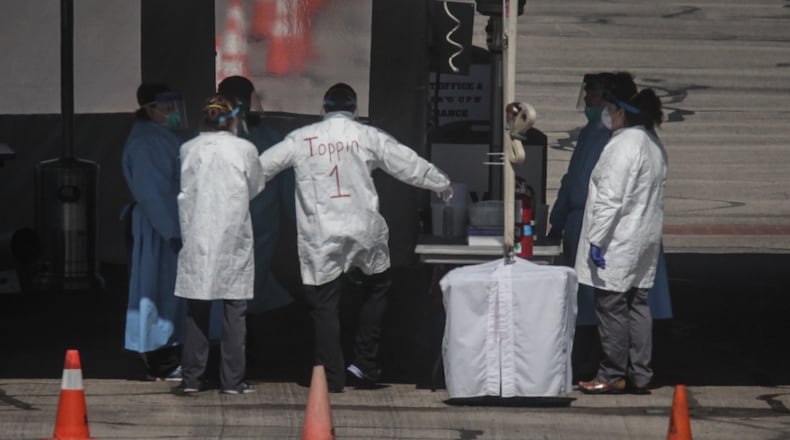Premier Health, which has been operating this region’s only drive-through testing in the UD Arena parking lot, said in a statement, “We’ve been actively pursuing doing the testing in-house for our hospital inpatients. We anticipate our in-house capabilities will be live yet this week.”
Testing results for the coronavirus have lagged in Ohio and nationwide, leaving ill people (and the people who come in close contact with them) waiting for days or over a week for results.
Gov. Mike DeWine has urged hospitals to send more tests to neighboring hospitals with capacity or to Ohio Department of Health’s laboratory, which is turning around test results faster than private labs.
On Wednesday Dr. Amy Acton, who leads Ohio Department of Health, said she was turning that plea into an order that all hospitals without their own testing will need to send tests to other hospitals with capacity to test.
In the Dayton area, Moraine laboratory CompuNet — which Premier Health owns a majority ownership stake in — doesn’t yet have the ability to test for COVID-19 but is working toward in-house testing. CompuNet is like many U.S. laboratories that has been unable to get the all supplies needed to run these COVID-19 tests.
CompuNet in the meantime has been testing for 21 other respiratory illnesses that could be the culprit so they can quickly let people know if they have these other illnesses with similar symptoms. When no other illnesses are detected, the tests are sent to major lab company Quest which can test for the coronavirus that’s part of the outbreak.
Sending out of state takes time for transportation and Quest labs have received a flood of testing samples from all over the U.S.
In Ohio, Ohio State University Wexner Medical Center, Cleveland Clinic, and MetroHealth all have capacity to do testing. When announcing the order, Acton also revealed that some of these labs have a significant amount of capacity left un-used each day.
Ohio Department of Health has a public laboratory that can turn around results in about eight hours, but the lab has priority criteria for which tests it will take. The top priority at the state’s lab is for hospitalized patients and health care workers with symptoms. The second priority group is for patients with symptoms who are either in long term care facilities, 65 years or older, have underlying conditions or first responders. Premier’s outpatient collection site is not in these groups and is a “priority three.”
“Our collection site is a Priority 3; therefore, we are not to send it to them right now … The Ohio Department of Health laboratory criteria do not apply to outpatient testing sites at this time. That said, efforts are under way to expedite this testing to the extent possible,” Premier Health said in a statement.
More testing in the state could also help improve Ohio’s data collection, which has been fragmented among many different testers and not all private laboratories have shared negative tests with Ohio Department of Health. Negative tests, however, are important for understanding the full picture of what is happening.
DeWine added that rapid tests coming onto the market will be deployed across Ohio as soon as they are available, perhaps next week.
Columbus-based Battelle Memorial Institute and OSU jointly developed a test to diagnose COVID-19 in as few as five hours. Abbott Laboratories, which has operations in Ohio, announced its new, portable ID NOW COVID-19 test can deliver positive results in as little as five minutes and negative results in 13 minutes.
In order for business to return to normal, Ohio officials need to be able to tell where the virus is at and how contained it is. Widespread testing to confirm cases and later blood testing to determine who has recovered and now has immunity are key parts of getting to that point.
Dr. Ashish Jha, director of Harvard Global Health Institute, who has been one of the leading researchers following the U.S. outbreak response, posted online Thursday that he is again growing concerned about testing for COVID-19 in the U.S.
Testing capacity in the country had been growing but then fell flat at about 100,000 tests a day, and the percent of people testing positive has been inching up every day, from 15.5% a week ago to now 18.3%. Flat line testing but increasing infections means the country is likely falling behind in testing, he said.
“We can’t open up again without more testing,” Jha wrote.
About the Author
